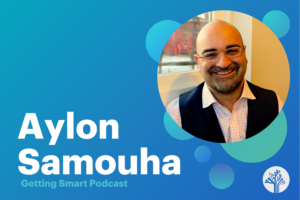EdTech Products Supporting ELL

Globalization means more interaction between native speakers of different languages. Continued immigration to the U.S. means more people that need to learn English. Both are served by the expansion of mobile access, the explosion of EdApps, and the rise of machine learning. EdTech investments of $3 billion last year resulted in improvements to hundreds of reading and writing apps and products specifically created for English Language Learners (ELL).
We spent the last month reviewing about a hundred programs and apps in 17 categories. The first eight categories reflect the general trend toward personalized learning, an extremely important benefit to ELL and all students with learning differences (i.e., most of them).
| ELA Products, ELL Supports | Common Use | Examples | Innovation Opportunity |
| Adaptive reading | Elementary supplement with ELL supports | i-Ready, iStation, Imagine Learning, Achieve3000, LightSail | More content and subjects |
| Leveled readers | Intermediate/middle grade supplement | Accelerated Reader, Lexia, Curriculet, Newsela, MyOn | More titles including open content, better recommendations |
| ELA & math courses with ELL supports | Core secondary curriculum with supports | Apex Learning, Fuel Education, Connections, HMH, Edgenuity, GreatMinds, PreK12Plaza | Personalized supports |
| ELA lessons with ELL supports | Open curriculum resources with ELL adaptations | Achieve the Core, EL Education, EngageNY, BetterLesson, LDC, ThinkCerca, LearnZillion, Pinterest, Quill | Platform integration with learner profiles, teacher coaching |
| Literacy tools with ELL supports | Digital reading and writing tools | OneNote Learning Tools | |
| Vocabulary & content videos | K-12 ELA & subject supplement | BrainPOP, Flocabulary, Study Island, Khan Academy | Personalized adaptive playlists |
| Writing feedback | Core secondary curriculum support | PEG, WriteToLearn, Lightside, WriteLab | Text-to-Speech, feedback translation, better UX |
| Reading Intervention | Secondary double block | Read 180, Achieve3000 | Personalized supports |
The next 6 categories are tools specifically focused on ELL teachers and students. Example and remaining innovation opportunities are summarized below.
| ELL Products | Common Use | Examples | Innovation Opportunity |
| ELL management | Program management, communication, reporting | ELLevation, e-ELL PRO, eStar ELL | Include/link to all other categories; mobile progress monitoring |
| ELL courseware | Secondary double block | ELLoquence, Learning Upgrade, Lingual Learning, Rosetta Stone, Middlebury, HMH | Adaptive assessment and supports |
| ELL listening | Informal, supplemental |
EnglishPodcast, Listen & Speak, Learn English Elementary (Android apps) |
Full text and support |
| ELL assessments | Track progress | Pearson TELL, WIDA | Instruction embedded |
| ELL conversations | Speak with native speakers | Busuu, WeSpeke | K-12 use with vetted mentors |
| ELL PD | Technical assistance, coaching, PD, PLC | Confianza, Lingual Learning, VIF, Edmodo | Links to resources, micro-credentials |
We also considered several general categories highly relevant to ELL.
| ELA Relevant Products | Common Use | Examples | Innovation Opportunity |
| Adaptive math | K-12 supplement | ALEKS, Dreambox, Reasoning Mind, ST Math, Knewton | Supports in multiple languages |
| Communication | K-12 parent communication with translation | Class DoJo, Remind, TalkingPoints, Google translate | Integration with learning platforms |
| Learning assistant | Image/voice recognition, content linking | Volley, Siri, Cortana | Links to profile, adaptive |
The last category, personalized learning assistants, is new and promising for all learners. Rapid progress in artificial intelligence (and specifically the categories discussed below) means that all learners will soon benefit from a customized course of study informed by a comprehensive learner profile–and, if we do this right, motivated and supported by teachers in rich learning environments.
Technologies with the potential to improve ELL support
To identify impact impact opportunities it’s helpful to take a quick dive into the underlying technologies behind these product categories and look at the status of the technology (i.e., in basic research, in applied research, used in product development, or mature)and its current level of adoption.
Natural language processing (NLP)
- Machine learning applications seeking to extract meaning from text
- Applications: translation, writing feedback, speech recognition, natural language generation, question answering, information retrieval
- Uses: writing feedback/scoring systems have been used for 15 years but are not widely adopted
- Potential use: conversation agent that can detect/promote levels of understanding; feedback on constructed response (untrained data)
- Impact potential: very high
- Stage: applied research & product development
Other Machine learning (ML)
- Algorithms that learn from and make predictions on data
- Applications: Assess and recommend optimal development pathways by learner type; determine the most efficient practice schedule and content for each learner
- Use: adaptive assessment, reading and math systems (widely adopted)
- Impact potential: high
- Stage: adaptive products are mature and widely adopted in blended deployment models; other ML apps are in applied research and product development
Voice recognition (VR)
- Speech recognition understands voice commands; digital voice signal processing detects proper/improper pronunciation
- Use: reading instruction, conversation with a smart agent
- Impact potential: moderate
- Stage: widely used as a search aid (e.g., Siri); other apps in research or development
Computer vision (CV)
- Image and facial recognition
- Use: ability for a computer to read a passage or recognize an image and provide and to translate it into speech in several languages and/or provide several relevant content links
- Impact potential: moderate
- Use: personal learning assistant when combined with camera, ML (Volley)
Augmented reality (AR)
- Live view augmented by computer information via mobile or headset
- Use: when combined with CV, ML, and NLP, could recognize objects, provide contextual conversation
- Impact potential: moderate
- Stage: applied research, product development
Virtual reality (VR)
- Immersive environments requiring headset
- Use: learning environments that with NLP and ML could provide full conversation support
- Impact potential: moderate
- Stage: applied research, product development
Learner profile (LP)
- Comprehensive record of progress and related learning factors (assessment results, motivational preferences, special challenges)
- Use: will inform every technology listed here and will provide recommendations to teachers
- Impact potential: high (for all students)
- Stage: applied research, will require industry standard(s) on assessment integration (see summary)
Telepresence
- Video conferencing with chat and content sharing often combined with distributed workforce strategies
- Use: tutoring and speech therapy (PresenceLearning)
- Impact potential: moderate
Automated assessment
- Automated assessment scoring, can be used to drive adaptive sequences
- Use: combine with standards (for reading, writing, speaking and listening) and teacher scored performance assessments to form micro-credential/badge sequences in competency-based systems
- Impact potential: moderate (full competency-based progressions that link formal and informal learning offer moderately high potential)
Translation
- Automated language translation
- Use: student support in content-based learning; parent communication
- Impact potential: moderate
- Stage: widely used in parent communication; some new apps in product development
Social media
- Platforms that connect and promote content sharing among groups and individuals
- Use: live, video, and text conversation with native speakers; professional learning communities for educators
- Impact potential: moderate
- Stage: widely used
Conclusion
Like all students, English language learners are benefiting from better access to technology, personalization tools, and blended learning models. They will also benefit from the longer transition to competency-based education where they progress based on demonstrated mastery. While progress has been steady, there remains an adoption gap, a standards gap, and an invention gap that must be addressed.
Adoption gap: writing feedback systems have steadily improved over the last 15 years but are not widely adopted as a result of poor user experience, weak access to technology and teacher skepticism about computer scoring. The dramatic improvement in secondary student access to technology suggests that demand aggregation strategies would be timely and effective. Pilot projects in high ELL districts would demonstrate use cases and product efficacy. Documenting use cases, conducting efficacy studies and providing adoption incentives would all be productive.
Standards gap: The sector needs a common method for combining formative assessment to verify progress in language acquisition. Like world languages (i.e., spanish speaking students earning AP credit), ELL is a perfect entry point for competency-based learning. A badge sequence based on multiple forms of assessment would be useful and would encourage extended learning opportunities.
Invention gap: The biggest opportunity in language acquisition is a smart personal agent, one that combines machine learning, natural language processing, computer vision, and voice recognition to provide live feedback on conversation (regarding vocabulary, pronunciation, and grammar) and six trait writing feedback. This EdApp would combine several of the product categories above and could be used across the curriculum and in support of informal learning.
Growing commitment to dual language fluency demands increased investment in dual language tools and content.
This blog is part of the Supporting English Language Learners Series with support from The Bill & Melinda Gates Foundation. For more, stay tuned for the culminating podcast, infographic and publication.
For more see:
- 5 Best Practices for Supporting Refugee ELL Students
- Next-Gen Personalized Learning for ELL Students
- Supporting ELL Students with Automated Writing Feedback
Stay in-the-know with all things EdTech and innovations in learning by signing up to receive the weekly Smart Update. This post includes mentions of a Getting Smart partner. For a full list of partners, affiliate organizations and all other disclosures please see our Partner page.







Tom Vander Ark
Also see iLit ELL, a grades 3-10 reading intervention program, built to support Newcomers to Long Term ELL's with embedded SIOP notes, translation into 45 languages, integration of the ELPS and a library or 3000 books that goes to Below Reader.